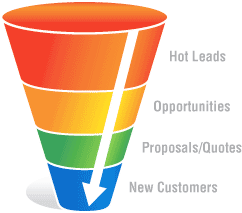
Article Contributed Joanne Black
We’ve been told that getting more sales is all about your “activity,” but is it?
Our job as salespeople is to move as many qualified prospects through the sales funnel as quickly as possible—leading to more sales, better clients, and more income.
The traditional sales funnel to attract new business has maintained the same structure for years. There’s a wide opening at the top and a skinny tube at the bottom. The traditional prospecting method crams as many prospects into the top of the funnel as possible, hoping that new clients will magically pop out of the other end. The only thing that mattered was sheer activity.
Today, I’m going to debunk the myth that sheer activity is the ONLY thing that matters along with two other myths that are holding you back from getting more clients now.
3 Sales Lead Generation Myths That Will Hold You Back From Closing More Sales
Myth #1 Sheer Activity is the Only Thing That Matters in Sales
Wrong! Of course, activity is still important, but what really matters is that you feed the right people into the funnel in the first place and nurture those prospects who have been referred to you. Then hasten their passage through the sales funnel. This will decrease the amount of time it takes to you close your sale.
Picture the funnel from the traditional “olden” days. If you just stuff as much as you can into the top of the funnel, it’s more likely that weeds, rocks, sand, and other debris will clog the opening and prevent the steady entry and flow of good business. Try pouring water in a funnel that is filled with debris. The water backs up and nothing moves through. Not a pleasing picture, and not functional business model. It’s certainly not one that fosters an environment for attracting new business.
Myth #2 Sales 2.0 Leads are Qualified
There’s so much that’s wrong about the traditional sales funnel, and it’s gotten worse in the Sales 2.0 world. It’s not a referral-marketing funnel. In the past, we were schooled to throw as many prospects in the funnel as we could find. For example, we were taught to get so-called leads from mailings, trade shows, advertising, networking, newsletters, and speaking. Now in the 2.0 world, we are taught to get so-called leads from blogging, videos, eBooks, free reports, press releases, eZines, affiliate traffic, RSS feeds, and email lists. We can now choose to waste our time by following up on these so-called leads.
I call the leads above “So-called leads” because these aren’t really leads.
They’re inquiries, possibly names—or people just interested in free stuff. Everyone likes free stuff. If we take the time to weed through all this trash, we might actually find a prospect. These people are just prospects. They’re not business referrals. And, they’re still not leads.
Myth #3 It’s Important to Sort “Leads”
We have to change how we talk about leads. Inquiries are not leads. People wanting free stuff are not leads. Neither are those “coveted” lists or files of names. Calling these “leads” borders on insulting.
Leads are people who:
- Are truly interested in talking directly to you about your products and services to see how you can help them
- Match the profile of your ideal client
- Have a budget
- Have a need that you can fulfill
- Are open to pursuing how you can help them attract new business.
Now that’s a qualified business referral.
The best leads are those you have received through a referral. When you receive a qualified referral, you are pre-sold. You have credibility and trust. Your sales time shortens. And, you ace out the competition. When you’ve been referred, you get a new client more than 50 percent of the time. Get more referrals and get these results.
So stop calling everyone and everything a lead. It’s is a waste of your valuable sales time. I’m not just splitting hairs over terminology. It is downright misrepresentation when companies position themselves as lead-generation experts. It sounds so good (so easy), so we jump. And that’s when we get our sales funnel clogged with trash instead of getting more referrals.
In this lagging and volatile economy, it’s easy to be lured by business which clogs our sales funnel. We can’t afford to attract the wrong kind of clients to our business. It’s like dumping trash in our sales funnel. A full funnel is only valuable if it’s filled with the kind of clients that are right for you – clients that are qualified and referred.
Think about it: What’s in your sales funnel?
About the Author:
America’s leading authority on referral selling and founder of No More Cold Calling, Joanne Black helps salespeople, sales teams, and business owners get more referrals and attract more business fast without increasing costs. Now, discover how to turn prospects into clients more than 50 percent of the time even during a down economy at http://www.nomorecoldcalling.com



